引子
我们已知,OC 中的类也是对象,且对象和类实际上是以结构体的形式存在的(可通过 clang 转换)。在 OC 运行时可以修改对象的方法和属性。那么,这些结论背后的机理是什么呢?
在这篇文章中,我将从类的内存布局以及内存结构方面入手,通过调试 objc runtime 的源代码来厘清上述问题(源代码版本为 objc4-706)。
isa_t 结构体
首先来认识一下 isa 指针,isa 的意思是 it is a object,这是一个对象。对象是由 objc_object 结构体定义的,类是由 objc_calss 结构体定义的,我们可以在 runtime 源码中查看它们的定义:
1 | struct objc_object { |
isa 定义
我们可以看到,对象的结构体中其实就只包含了一个 isa_t 联合类型的成员,类的结构体继承于对象的结构体,因此类的结构体的第一个成员也是 isa_t 联合类型,从这一点来讲,类也是对象。
1 | union isa_t |
关于联合类型,联合表示几个变量公用一个内存位置,在不同的时间保存不同的变量。当一个联合被说明时,编译程序自动地产生一个变量,其长度为联合中最大的变量长度。也就是说没,在任何同一时刻,联合只存放了一个被选中的成员。在 isa_t 联合结构中,共有三个成员,cls,bits,以及结构体变量。
isa 初始化
我们从 isa 的初始化来看 isa_t 联合中结构体各字段的意义。当为 OC 对象分配内存时(比如调用 alloc 方法),会初始化 isa 指针,其方法调用栈如下图所示:

其中 inline void objc_object::initIsa(Class cls, bool nonpointer, bool hasCxxDtor) 方法的定义如下:
1 | inline void |
以 x86_64 架构为例,ISA_MAGIC_VALUE 为 0x001d800000000001,在执行 newisa.bits = ISA_MAGIC_VALUE; 这行代码之后,newisa 的结构如下图:
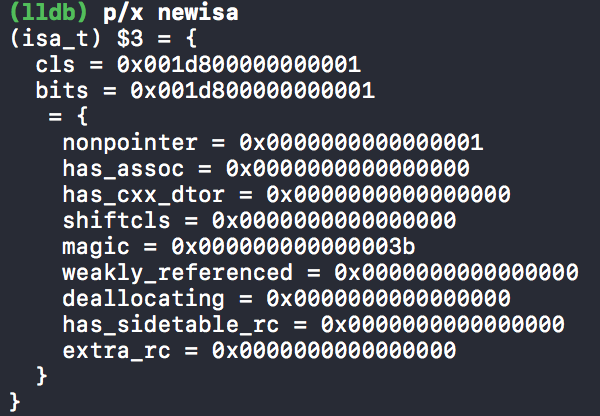
正如注释中提到的,执行这行代码,给 magic 和 nonpointer 赋值,nonpointer 是第0位,为1,magic 是第4752位,为111011。接下来再将传入的 hasCxxDtor 赋值给 newisa.has_cxx_dtor,cls右3位赋值给 newisa.shiftcls。因为 shiftcls 是类或元类的指针,所以肯定是对齐的,也就是以0或8结尾,所以第02位在 isa 指针中就被占用来记录其他信息了(nonpointer、has_assoc、has_cxx_dtor )。
isa 各字段的含义:
- nonpointer:表示isa_t 的类型,0表示这是一个指向 cls 的指针(iPhone 64位之前的 isa 类型),1表示当前的 isa 并不是普通意义上的指针,而是 isa_t 联合类型,其中包含有 cls 的信息,在 shiftcls 字段中。
- has_assoc:对象含有或曾经含有关联引用,没有关联引用可以更快释放内存。
- has_cxx_dtor:表示该对象是否有 C++ 或 ARC 的析构函数,如果没有析构器就会快速释放内存。
- shiftcls:当前对象对应的类指针,或当前类对应的元类指针。
- magic:0x3b,用于调试器判断当前对象为真的对象还是未初始化的空间。 (即判断是否完成初始化)
- weakly_referenced:对象是否指向或曾经指向一个 ARC 的弱变量,没有弱引用的对象可以更快释放。
- deallocating:对象正在释放内存。
- has_sidetable_rc:该对象引用计数太大,isa 指针存不下了。
- extra_rc: 存储引用计数值减一后的值。
isa->shiftcls
通过前面提到的 objc_object 的定义,我们可以看到,对象的结构体中仅仅只有一个 isa 指针,并没有保存对象的属性、方法等。因为如果每一个对象都保存了自己能执行的方法,那么会占用很多的内存。
当实例方法(减号方法)被调用时,是通过对象的 isa 指针来查找对应的类(shiftcls 字段),然后在 objc_class 的 class_data_bits_t 结构体中查找本类方法的实现,superclass 中查找父类方法。
调用实例方法,也就是向对象发送消息。那么调用类方法(加号方法),也是在向类发送消息。正如我们前面提到的,类也是一个对象,类对象的类是它的元类(meta class)。所以类方法存储在元类结构中。
元类当然也是一个对象(为 objc_class 结构),它所属的类是根类(NSObject)的元类,根元类的类就是它自己。总的来说,对象的 isa->shiftcls 指向其所属类,类的 isa->shiftcls 指向元类,元类的 isa->shiftcls 指向根元类,根元类指向它自己。
可以通过 ISA() 来获取 isa->shiftcls:
1 | inline Class |
即通过 ISA_MASK 掩码获取。
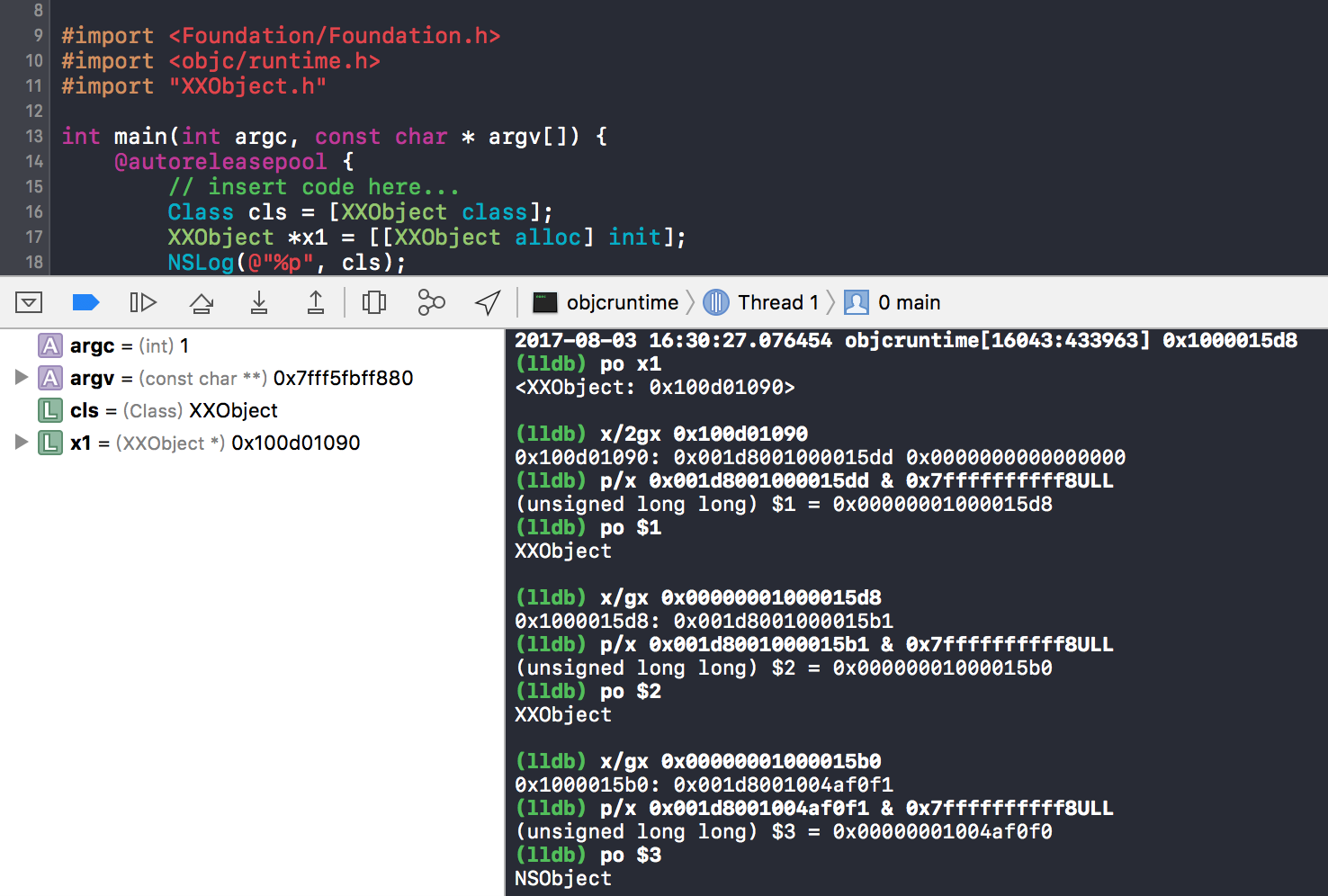
在上图中(x86_64),x1是一个对象,$1是x1的 isa->shiftcls 指向的类,$2是$1的 isa->shiftcls 指向的元类,$3是$2的 isa->shiftcls 指向的根元类。
class_data_bits_t 结构体
Class superclass 是当前类的父类指针,cache_t cache 在我之前的一篇文章“通过汇编解读 objc_msgSend”中有详细讲解。
class_data_bits_t 结构体只包含有一个 uintptr_t 类型的 bits。另外我们可以通过它的 data() 方法,访问64位中的第3~47位,返回一个 class_rw_t* 指针。objc_class 中的 data() 方法仅仅是对它做了一个封装。
1 | struct class_data_bits_t { |
在 objc_class 的注释中提到,class_data_bits_t 结构体就是 class_rw_t 指针加上 rr/alloc 标志。
class_rw_t & class_ro_t
1 | struct class_rw_t { |
很明显可以看到,类中的方法、属性、协议等都保存在 class_rw_t 结构体中。其中的 class_ro_t 结构体保存的是当前类在编译期间就已经确定的属性、方法以及遵循的协议。
编译期间:
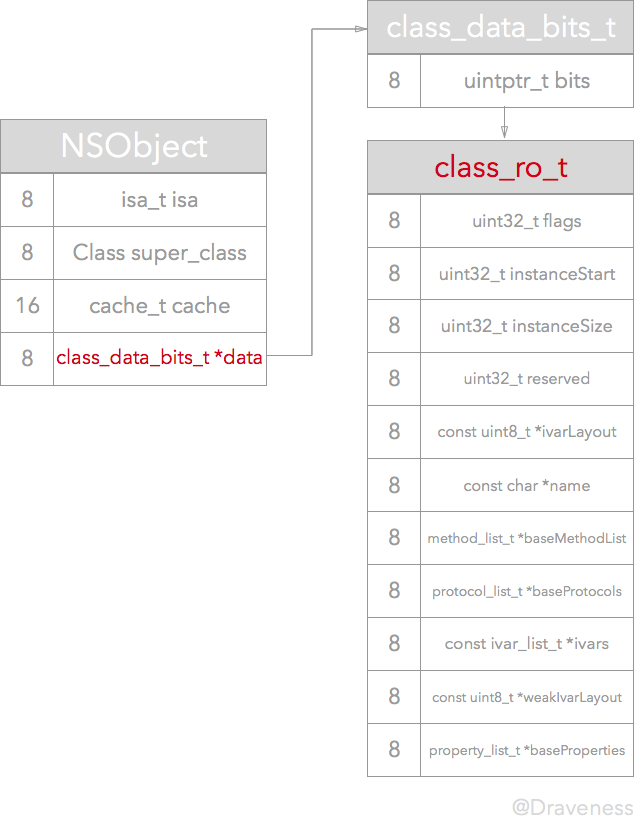
运行后:
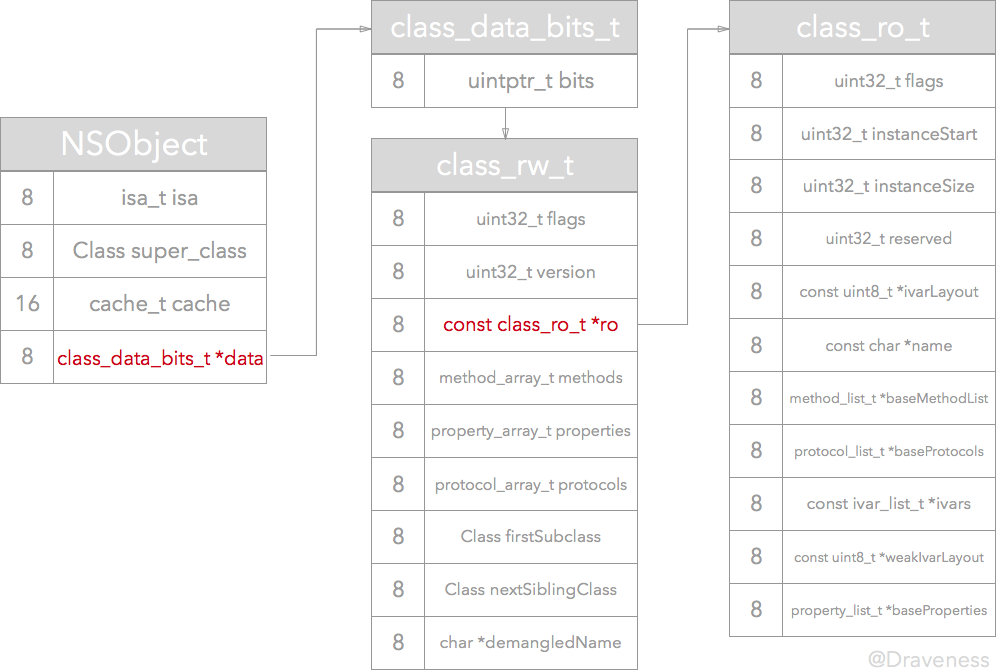
以上两张图来自 Draveness 的博客:深入解析 ObjC 中方法的结构
这个变化来自于,在对类进行初始化的 realezeClass 方法:
1 | static Class realizeClass(Class cls) |
其中 methodizeClass 方法将类自己实现的方法、属性和协议加载到 class_rw_t 的 methods、properties 和 protocols 中。
我们新建一个类:
1 | // XXObject.h |
XXObject 这个类遵循 XXObjectProtocol 协议,并实现了其中的 hello 方法。定义并实现了类方法 myClassMethod。在 main 函数中初始化这个类的实例,然后运行一次,获取 XXObject 在内存中的地址。我的是0x1000015d8。再在 realizeClass 方法内, rw 还未赋值之前下条件断点,如下图:

然后运行:

可以看到在断点处打印 bits.data() 返回的是 class_rw_t * 指针,继续打印 class_rw_t 结构体的值,并不对,因为在 realizeClass 方法中的 rw 被赋值前,应该是 class_ro_t 结构体类型,如下图:

接着可以打印 ro 结构体内的方法列表,即编译期间确定的该对象的方法,存储在只读区域,有遵循协议实现的 hello 方法,还有 .cxx_destruct 这个编译器自动生成的方法(用来在 ARC 下释放对象的实例变量),以及属性 myproperty 的 setter、getter 方法。如下图:
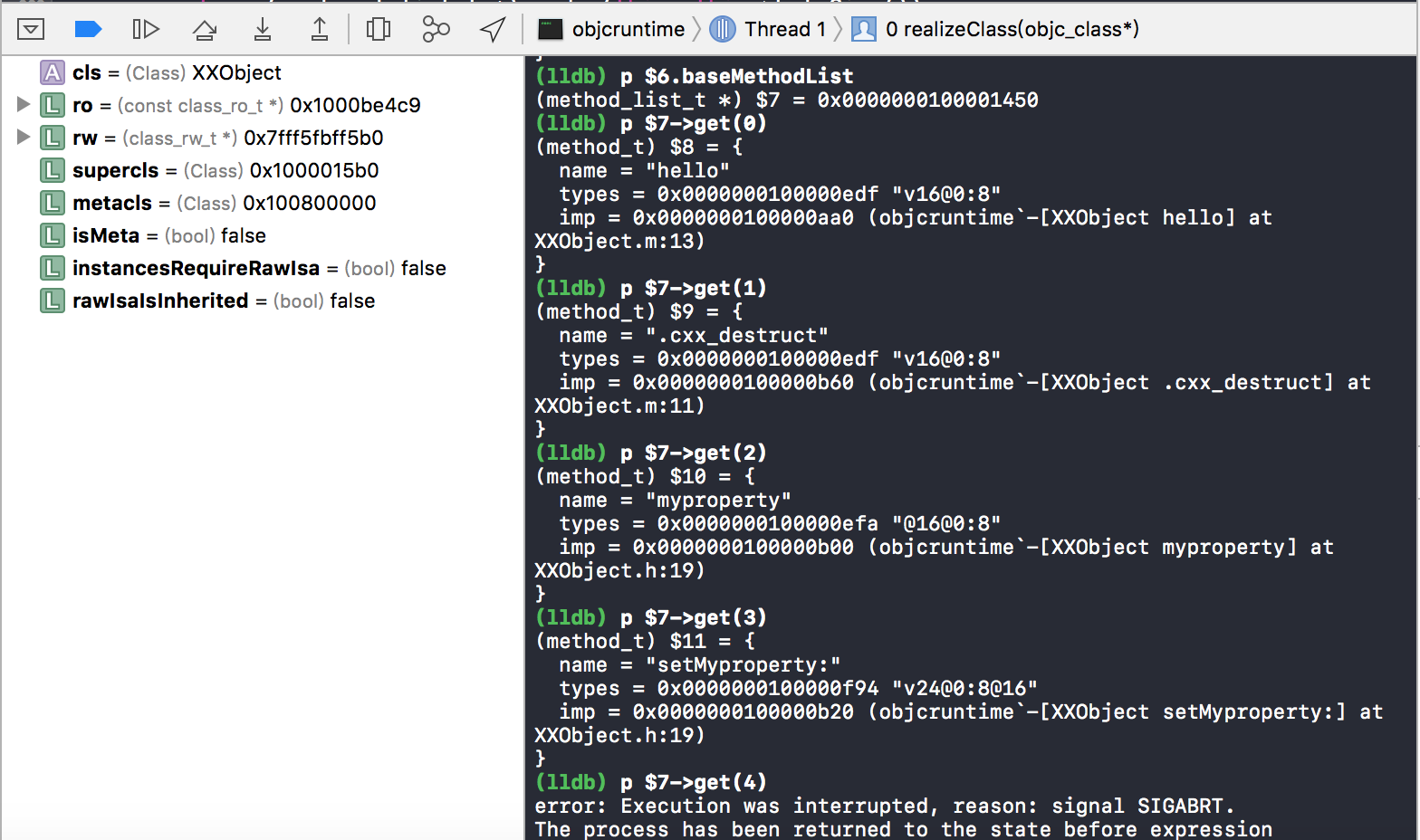
打印 ro 结构体内的属性列表,如下图:

打印协议,protocol_list_t 没有 get 方法,它的结构是这样的:
1 | struct protocol_list_t { |
所以第一个64位表示该对象遵循的协议的数量,紧接着是协议列表,如下图:
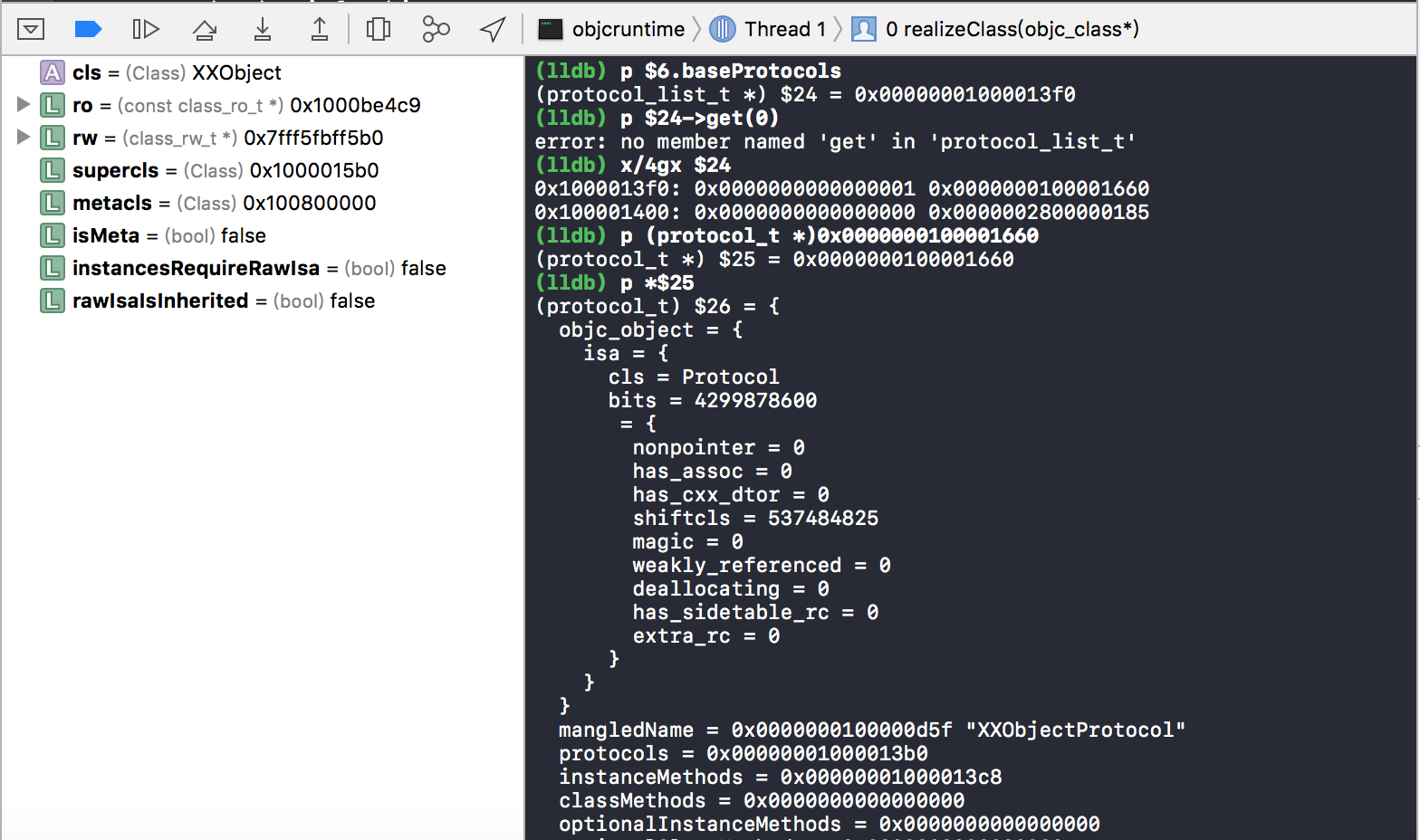
在运行完对 rw 的赋值之后,再查看 class_data_bits_t * 指针,其指向的内存地址已经改变,从之前的 class_ro_t * 指针 0x100001538 变为真正的 class_rw_t * 指针的地址 0x100802d20。打印发现 class_rw_t 结构体中的 ro 已被设置为 class_ro_t * 指针的地址。如下图:
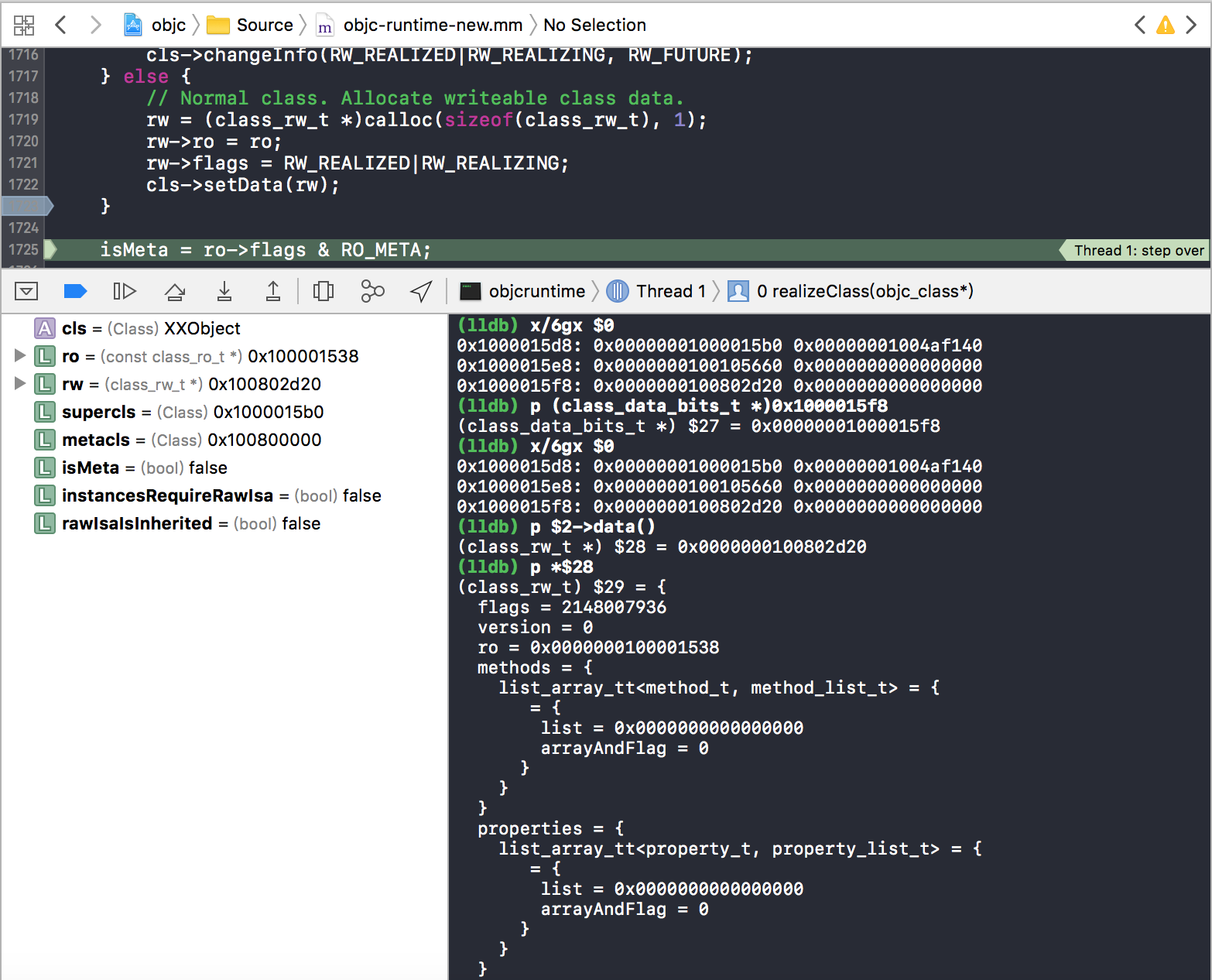

methods、properties等仍为0,在 realizeClass 方法末尾处的 methodizeClass 方法执行完,才会被赋值,且与 ro 中的方法列表等指针地址相同。
动态添加方法
如果动态添加方法的话,又会被存在什么位置呢?我们将 main 函数修改为下面的代码:
1 | int main(int argc, const char * argv[]) { |
在 [x1 performSelector:come]; 处下断点:
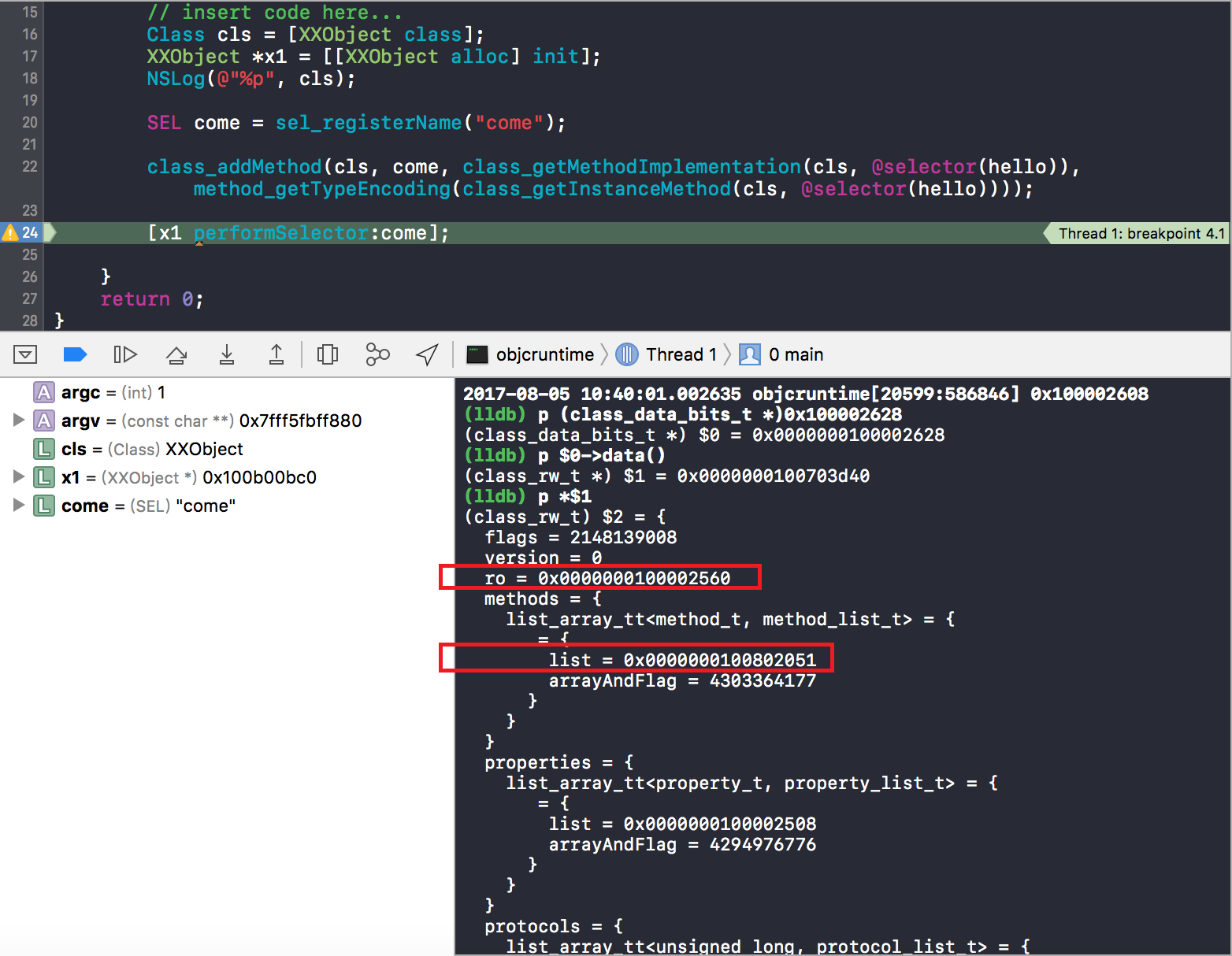
打印 class_rw_t * 指针的地址,可以看到 methods 的指针为 0x100802051,地址末尾为1,标明这是 thumb 架构,打印的时候减1即可。通过 $3 可以看见,直接强制转换为 method_list_t * 指针,并不能打印处方法的地址。我们打印 0x100802050 处的内存,可以看到首先是 0x2,这是标明当前方法列表的数目,0x100802030 即是动态增加的方法列表的指针,0x100002478 是 ro.baseMethodList 的指针:
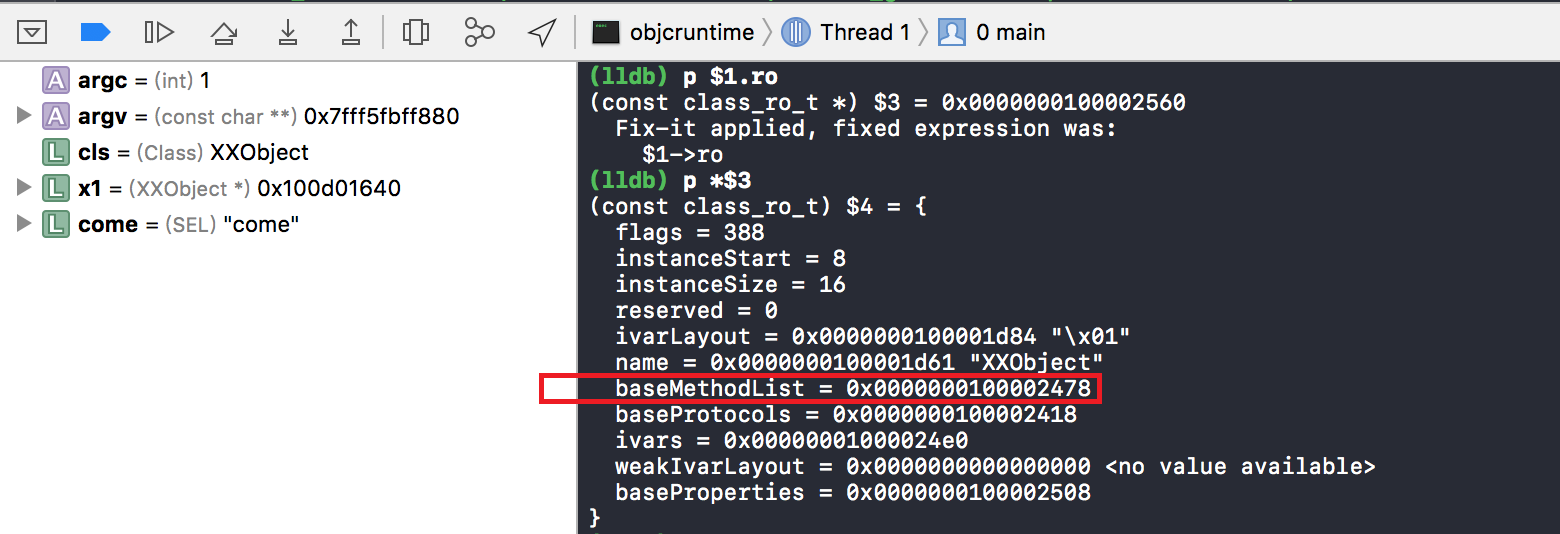

所以,动态添加的方法只修该 rw 中 methods 的内存布局,对编译期间就确定的 ro 中的 baseMethodList 没有影响。 ro 的结构是在编译期确定的,在运行期间不可更改。
Reference
[1] 深入解析 ObjC 中方法的结构 http://draveness.me/method-struct.html
[2] 从 NSObject 的初始化了解 isa http://draveness.me/isa.html
[3] 用 isa 承载对象的类信息 http://www.desgard.com/isa/
[4] 我们的对象会经历什么 http://www.jianshu.com/p/ff8a7c458c96